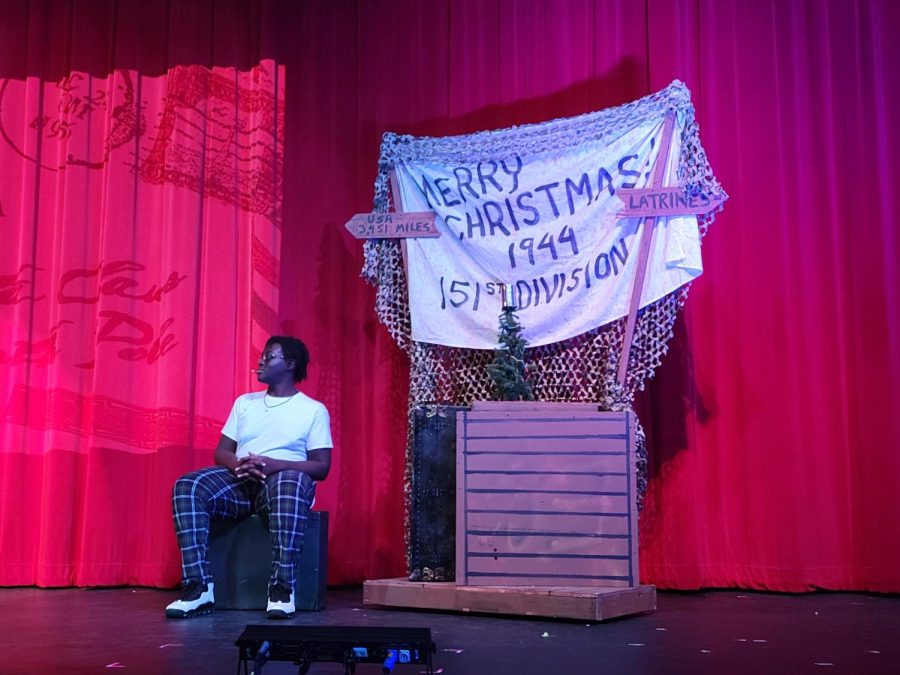Behind the Scenes: BSM Theater
Theater Crew of White Christmas
Cast member Jeremiah Russell rehearses in preparation for the whirlwind White Christmas’s opening night.
Going to a play has always been an awe-inspiring experience, but most people don’t know how much happens behind the red curtains of opening night. With costumes, intricate set pieces, dramatic lighting, and musical numbers to remember, there’s a lot that goes into the productions at BSM.
Months before the auditions even start, Jake Mahler, artistic director of the drama department, is working to find the perfect show. Mahler needs to apply for the rights to the plays and make sure they’re applicable to BSM, as explicit and overly elaborate shows are off the table. “If I’m looking for a play, I’m going to be listening to music and finding the scripts that I can read, trying to pick something that feels like it actually fits the student body that we have… It’s hard to find a show that’s gonna fit with all the criteria,” Mahler said.
The next step is working with the people behind the scenes. The choreography, lights, set, and costumes need to be coordinated in adapting the play to BSM’s theater and capabilities.
Costumes mainly come from Caroline Stroh, who has been working as BSM’s costume designer on and off for years. This complicated job includes ordering dresses that may not even arrive, and piecing together things from BSM’s costume room. “Some of it gets provided by the students but most of it Caroline either finds, builds, or has down in stock,” Mahler said.
Robin McIntyre builds a huge part of set design for BSM, and his connections with other schools allows the theater departments to trade around props. Though students and parents assist on occasion, Mahler hopes to return to set-building classes during school. “We’re hoping to, in the next couple of years, maybe get back to having a class where [students work] on building the sets for the shows,” Mahler said.
Sue Berger is BSM’s lighting designer, though students are working with the lighting board and spotlights during the play’s production. BSM often rents more advanced lights and other technical equipment to add to the plays. “We don’t have the most amazing set of lights available to us, so we often have to rent a couple of smart lights that we can put up that can do a little more fancy stuff for each show,” said Mahler.
After figuring out the basis of the play, the auditioning process begins. Though the singing, dancing, and reading sections of the audition are meant to gauge the talent and attitude needed for lead roles, as many people as possible are allowed to participate.
“The auditioning process is three separate parts. First, you do a singing audition, where you’re going to learn on your own a one minute snippet of any musical Broadway song… [for] the dance audition, you’re going to learn probably a one to two minute snippet of one of the dances from the show… And they’ll assess how quickly you pick things up… And then finally, the choreographer and all of the casting people will talk and decide who they want to read for specific characters… you read those scenes for the director and the casting people so that they can get a feel for what you’d be like as that character,” actress Betsy Brill said.
Most practices work on anything from reading lines, practicing singing, to running through full scenes. However, on days when choreographer Megan Kelly Hubbell is available, practices mainly consist of working on dances. “For choreography days, we’ll all be together running through different songs, depending on who’s in what… And then we’ll do it a couple of times, until it’s more cleaned up, compared to what we started with,” Brill said.
Tech week is the most complicated part of the process, as it includes a longer practice time and puts all the pieces of the show together. The actors, costume designers, lights, technical, and backstage workers all get the chance to practice what they’ve been working on. “Tech week is the week right before the show, where we start adding in lights. We add in microphones, we add in costumes, and we added a bunch of set pieces… So it’s more of the tech people’s time to get their part down,” assistant stage manager Grace Ehrmantraut said.
Though there have been up to 40 people involved in a play, the amount of actors has gone down due to stricter sports requirements and less free time. However, for those that do participate, it’s become a welcoming, friendly environment. “I think we are really welcoming… it has become sort of like a safe space for people to just be themselves,” actor Lance Hoover said.
“High school is really easy to feel lost… [students] can be their true selves without… worrying about being made fun of. You get to be complicated, to be silly, and you get to put on a hat, and you get to dance around,” said Mahler.
As opening night for White Christmas is Thursday, November 17th, Ehrmantraut has one last thing to say on behalf of all the theater crew: “Come see the show.”




































![Teacher Lore: Mr. Hillman [Podcast]](https://bsmknighterrant.org/wp-content/uploads/2025/03/teacherlorelogo-1200x685.png)





